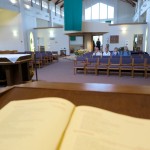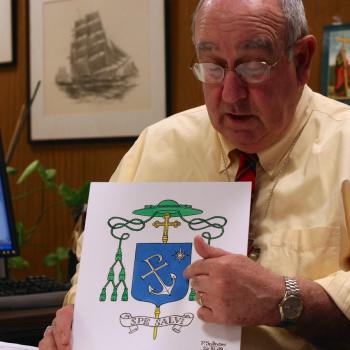While the subject has popped up at the Synod this week, and seems to be generating some buzz, the topic of women deacons is hardly new to some churches in the East.
The Coptic Church, for example, has a long history of deaconesses, but the office is not conferred by ordination and seems roughly akin to being a religious sister or nun:
Originally in the Church, during the Divine Liturgy, there was the celebrant priest(s), the altar deacon(s), and the congregation led in the hymns by the cantor (the mo’alem). Nowadays, the majority of the deacons are either chanters (psalters) or readers (augnostos). Neither of these ranks are ordained by the laying on of hands, but receive special prayers for blessing. The ranks of the chanter and reader are the first steps towards preparing the young men to fully understand the responsibilities of an ordained deacon, of which learning the Church’s hymnology is just one aspect. Since everyone should be chanting and participating in the Liturgy, then it really does not matter whether we are standing in the forefront wearing the deacon’s special garments of the robe and stole or whether we are standing inconspicuously unnoticed with the rest of the congregation. All the Church Fathers and Christ Himself teach us that we should never seek the first place nor the glory of being prominent. Our Christianity elevates the servant and submissive ones, not the one who wants to be prominent and distinguished. Therefore, as females we should not be bothered by the fact that we are not in the forefront; it is women who actually benefit from this arrangement since a truly Christian life must have humility and self-denial. Exercising authority is dangerous and difficult to do in a Christian way. Instead, let us learn from the Most Holy Virgin Mary to stand in humility before God and worship Him with awe and piety.
The Office of the Deaconess:
In the patristic era, there were three specific offices in the Church in which a woman could serve: deaconess, widow, and virgin. For all practical purposes, we will briefly mention the offices of widow and virgin and discuss the office of the deaconess (female diaconate) in more detail. The offices of widow and virgin were not ordained positions, but were entered by a personal vow. Their ministry consisted mostly of prayer, charitable work, and exemplification of virtuous Christian living. We still have the office of virgins, but in the form of the female monastics (nuns). Instead of living in groups in private homes, now they live in monasteries. As for the office of deaconess, they were consecrated by the bishop in a special ceremony. They were not ordained since the laying-on of hands was not involved. Their ministry included charitable work and in attending to the sick, poor, and all women and children, who needed help. They also prepared women for baptism, as well as assisted during their baptism.
After disappearing, the office made a come back in the 20th century:
The office of deaconess was restored in our Church by the Holy Synod, headed by H.H. Pope Shenouda III, and it is regulated by defined and specified bylaws. This was not intended as a political or theological statement for the equality of women, but because it was determined that there is a practical and definite need for it. We must remember that all of us as members of the Body of Christ, whether males or females, young or old, are called to be intimately united to our Lord Jesus Christ. This is possible only if we purify our hearts and offer to our Lord our thoughts, feelings, and acts to sanctify them. Again, this is possible only if we live the inner life of the Holy Church by being active participants. Each one of us has the potential, by God’s grace, to reach the highest goal, which is communion with Christ in this life and in the life to come in the Heavenly Jerusalem.
The Armenian Apostolic Church, also uses women as deacons, or deaconesses, and it is an ordained office:
The diaconate is one of the major orders in the Armenian Church. The word deacon means to serve ‘with humility’ and to assist. The Armenian deaconesses historically have been called sargavak or deacon. They were also referred to as deaconess sister or deaconess nun. The other major orders of the church are bishop and priest. The deaconesses, like the bishops and monks, are celibate. Their convents are usually described as anabad, meaning, in this case, not a ‘desert’ as the word implies, but rather ‘an isolated location where monastics live away from populated areas.’ Anabads differ from monasteries in their totally secluded life style. In convents and monasteries, Armenian women have served as nuns, scribes, subdeacons, deacons, and archdeacons (‘first among equals’), as a result not only giving of themselves, but enriching and contributing much to our nation and church. In the 17th century, for example, the scribe and deaconess known as Hustianeh had written ‘a devotional collection of prayers and lives of the fathers, and a manuscript titled Book of Hours, dated 1653.’
…To appreciate more fully the role of the deaconess in the church, Father Abel Oghlukian’s book, The Deaconess In The Armenian Church, refers to Fr. Hagop Tashian’s book Vardapetutiun Arakelots… (Teachings of the Apostles…), Vienna, 1896, and Kanonagirk Hayots (Book of Canons) edited by V. Hakobyan, Yerevan, 1964, in which a most striking thought is expressed:
If the bishop represents God the Father and the priest Christ, then the deaconess, by her calling, symbolizes the presence of the Holy Spirit, in consequence of which one should accord her fitting respect.
“Over the centuries, in some instances, the mission of the Armenian deaconesses was educating, caring for orphans and the elderly, assisting the indigent, comforting the bereaved, and addressing women’s issues. They served in convents and cathedrals, and the general population…
Check out the links for more.
UPDATE: A priest friend points out that you don’t really have to look East; the Carthusian nuns sometimes wear vestiture similar to clergy:
After her solemn profession or perpetual donation, the nun can, if she wishes, receive the Consecration of Virgins. This is a special rite where the Bishop gives the nun not only the veil and ring, external signs of an indissoluble union with the divine Spouse, but also the stole. This confers on the recipient certain liturgical privileges the most significant of them being the proclaiming of the Gospel on certain occasions.
My friend seems to recall that the nun who proclaims the gospel in the Carthusian house wears a deacon stole to do so.














